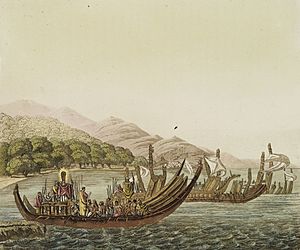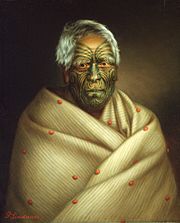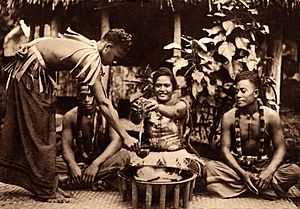Polynesians facts for kids
| Total population | |
|---|---|
| c. 3,200,000 | |
| Regions with significant populations | |
| New Zealand | 1,157,478 |
| United States | 988,519 |
| Australia | 409,805 |
| French Polynesia | c. 215,000 |
| Samoa | 192,342 |
| Tonga | 103,036 |
| Cook Islands | 17,683 |
| Canada | 10,760 |
| Tuvalu | 10,645 |
| Chile | 9,399 |
| Languages | |
| Polynesian languages (Hawaiian, Māori, Rapa Nui, Samoan, Tahitian, Tongan, Tuvaluan and others), English, French and Spanish | |
| Religion | |
| Christianity (96.1%) and Polynesian mythology | |
| Related ethnic groups | |
| other Austronesian peoples, Euronesians | |
Polynesians are a group of people who are native to Polynesia. This is a large area of islands in the Pacific Ocean. They are part of a bigger group called the Austronesian peoples. Their ancestors came from Island Southeast Asia a long, long time ago.
Polynesians speak Polynesian languages. These languages are part of the larger Austronesian language family. The biggest Polynesian groups today are the Māori in New Zealand, followed by Samoans, Native Hawaiians, Tahitians, and Tongans.
Around 2 million Polynesians live around the world today. Most of them live in independent island nations like Samoa and Tonga. Many also live in countries like New Zealand, Australia, and the United States.
Polynesians are famous for being amazing sailors. They used special skills to read the stars, ocean currents, clouds, and even bird movements. This helped them travel huge distances across the Pacific Ocean. They settled islands as far away as Hawaii, Easter Island, and New Zealand.
Where Polynesians Come From

Polynesians are a part of the Austronesian peoples. This means they share common ancestors with people from Taiwan, Maritime Southeast Asia, Micronesia, and Madagascar. Scientists have found this out by studying their DNA, languages, and old tools.
Most scientists believe that the ancestors of the Austronesian people came from Taiwan between 3000 and 1000 BC. They were very skilled at building boats. They used advanced canoes like catamarans and outrigger boats. These boats helped them travel across huge parts of the Indian Ocean and the Pacific Ocean. They were the first people to cross such long distances over the open ocean.
The direct ancestors of Polynesians are thought to be the Neolithic Lapita culture. This group appeared in Island Melanesia and Micronesia around 1500 BC. They were known for their special pottery with unique patterns. They sailed east and reached islands like Fiji, Samoa, and Tonga by about 900 BC.
For about 1,500 years, they stayed in these western Polynesian islands. Then, around 700 AD, they started sailing east again. They spread to the Cook Islands, French Polynesia, and the Marquesas. From there, they continued their journey. They reached Hawaii by 900 AD, Easter Island by 1000 AD, and finally New Zealand by 1200 AD.
What DNA Tells Us

Studies of Polynesian DNA show that most of their genes come from their Austronesian ancestors. A smaller part of their genes comes from people who were already living in Melanesia. This suggests that the Austronesian ancestors of Polynesians moved through Melanesia quite quickly. They mixed a little with the local people there.
More recent studies also suggest that the earliest Lapita settlers mostly sailed past New Guinea. They came directly from Taiwan or the northern Philippines. Any mixing with the people of New Guinea happened later, after they had settled in places like Tonga and Vanuatu.
A study in 2020 found something very interesting. Polynesians and the Indigenous peoples of South America met around the year 1200. This was centuries before Europeans arrived in either place.
Polynesian Peoples Today


Today, there are about 2 million Polynesians in the world. Many more people have some Polynesian heritage. Most Polynesians live in their home islands, or in countries like the United States, Australia, and New Zealand.
Here are some of the main Polynesian groups:
- Māori: They live in New Zealand (called Aotearoa in Māori). There are about 892,200 Māori in New Zealand, and many more live in Australia and other parts of the world.
- Samoan: They live in Samoa and American Samoa. There are about 249,000 Samoans in these islands, and many more live in the US and New Zealand.
- Tahitians: They live in Tahiti and other islands of French Polynesia. About 178,000 Tahitians live there.
- Hawaiians: They are the native people of Hawaii. Around 140,000 Hawaiians live there.
- Tongan: They live in Tonga. About 104,000 Tongans live in Tonga, with many others in Australia, the USA, and New Zealand.
- Cook Islands Māori: They live in the Cook Islands. Many also live in New Zealand and Australia.
- Niuean: They are from Niue. Most Niueans live in New Zealand.
- Tuvaluan: They are from Tuvalu.
- Tokelauan: They are from Tokelau.
- Rapanui: They are the native people of Easter Island (also called Rapa Nui).
There are also smaller Polynesian groups living in other parts of the Pacific. These are often called "Polynesian outliers." They include people from islands in Micronesia, Papua New Guinea, Solomon Islands, Vanuatu, and New Caledonia.
See also
 In Spanish: Pueblos polinésicos para niños
In Spanish: Pueblos polinésicos para niños
- History of the Polynesian people
- Polynesia
- Polynesian culture
- Polynesian languages
- Polynesian mythology
- Austronesian peoples

